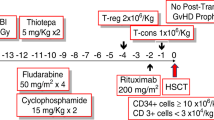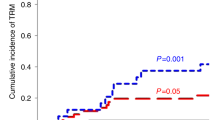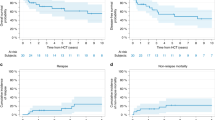Abstract
We evaluated the feasibility of T-cell-depleted haploidentical hematopoietic SCT (HHCT) in pediatric patients. Between July 2008 and January 2013, 28 patients underwent ex vivo T-cell-depleted HHCT; 9 had hematologic malignancy, 18 had nonmalignant hematologic disease, and 1 had refractory neuroblastoma. Twenty-six patients achieved neutrophil engraftment at a median of 11 days (range, 9–15 days). Two patients failed to achieve primary engraftment and five experienced graft rejection after primary engraftment. These seven patients achieved stable engraftment after a second HHCT. The cumulative incidences (CIs) of⩾grade II and⩾grade III acute GVHD were 33.3% and 14.3%, respectively, and the 1-year CI of extensive chronic GVHD was 11.1%. Four patients died of non-relapse-related causes (two of CMV disease, one of encephalopathy and one of autoimmune hemolytic anemia) and one of leukemia relapse. Non-relapse mortality at 100 days, 1 year and 2 years was 0.0%, 10.7% and 14.3%, respectively. At a median follow-up of 32.8 months (range, 17.0–72.5 months), the 2-year OS was 82.1%. OSs for nonmalignant diseases and malignant diseases were 94.4% and 60.0%, respectively (P=0.019). Thus, HHCT is a realistic alternative for patients with malignant or nonmalignant diseases who lack a suitable donor.
This is a preview of subscription content, access via your institution
Access options
Subscribe to this journal
Receive 12 print issues and online access
$259.00 per year
only $21.58 per issue
Buy this article
- Purchase on Springer Link
- Instant access to full article PDF
Prices may be subject to local taxes which are calculated during checkout




Similar content being viewed by others
References
Chen X, Hale GA, Barfield R, Benaim E, Leung WH, Knowles J et al. Rapid immune reconstitution after a reduced-intensity conditioning regimen and a CD3-depleted haploidentical stem cell graft for paediatric refractory haematological malignancies. Br J Haematol 2006; 135: 524–532.
Handgretinger R, Chen X, Pfeiffer M, Mueller I, Feuchtinger T, Hale GA et al. Feasibility and outcome of reduced-intensity conditioning in haploidentical transplantation. Ann N Y Acad Sci 2007; 1106: 279–289.
Bethge WA, Faul C, Bornhauser M, Stuhler G, Beelen DW, Lang P et al. Haploidentical allogeneic hematopoietic cell transplantation in adults using CD3/CD19 depletion and reduced intensity conditioning: an update. Blood Cells Mol Dis 2008; 40: 13–19.
Lang P, Schumm M, Greil J, Bader P, Klingebiel T, Muller I et al. A comparison between three graft manipulation methods for haploidentical stem cell transplantation in pediatric patients: preliminary results of a pilot study. Klin Padiatr 2005; 217: 334–338.
Im HJ, Koh KN, Choi ES, Jang S, Kwon SW, Park CJ et al. Excellent outcome of haploidentical hematopoietic stem cell transplantation in children and adolescents with acquired severe aplastic anemia. Biol Blood Marrow Transplant 2013; 19: 754–759.
Park JA, Koh KN, Choi ES, Jang S, Kwon SW, Park CJ et al. Successful rescue of early graft failure in pediatric patients using T-cell-depleted haploidentical hematopoietic SCT. Bone Marrow Transplant 2013; 49: 270–275.
Filipovich AH, Weisdorf D, Pavletic S, Socie G, Wingard JR, Lee SJ et al. National Institutes of Health consensus development project on criteria for clinical trials in chronic graft-versus-host disease: I. Diagnosis and staging working group report. Biol Blood Marrow Transplant 2005; 11: 945–956.
Przepiorka D, Weisdorf D, Martin P, Klingemann HG, Beatty P, Hows J et al1994 Consensus Conference on Acute GVHD Grading. Bone Marrow Transplant 1995; 15: 825–828.
Schumm M, Feuchtinger T, Pfeiffer M, Hoelle W, Bethge W, Ebinger M et al. Flow cytometry with anti HLA-antibodies: a simple but highly sensitive method for monitoring chimerism and minimal residual disease after HLA-mismatched stem cell transplantation. Bone Marrow Transplant 2007; 39: 767–773.
Bader P, Soerensen J, Jarisch A, Ponstingl E, Krenn T, Faber J et al. Rapid immune recovery and low TRM in haploidentical stem cell transplantation in children and adolescence using CD3/CD19-depleted stem cells. Best Pract Res Clin Haematol 2011; 24: 331–337.
Palma J, Salas L, Carrion F, Sotomayor C, Catalan P, Paris C et al. Haploidentical stem cell transplantation for children with high-risk leukemia. Pediatr Blood Cancer 2012; 59: 895–901.
Gonzalez-Vicent M, Molina B, Andion M, Sevilla J, Ramirez M, Perez A et al. Allogeneic hematopoietic transplantation using haploidentical donor vs. unrelated cord blood donor in pediatric patients: a single-center retrospective study. Eur J Haematol 2011; 87: 46–53.
Perez-Martinez A, Gonzalez-Vicent M, Valentin J, Aleo E, Lassaletta A, Sevilla J et al. Early evaluation of immune reconstitution following allogeneic CD3/CD19-depleted grafts from alternative donors in childhood acute leukemia. Bone Marrow Transplant 2012; 47: 1419–1427.
Dufort G, Pisano S, Incoronato A, Castiglioni M, Carracedo M, Pages C et al. Feasibility and outcome of haploidentical SCT in pediatric high-risk hematologic malignancies and Fanconi anemia in Uruguay. Bone Marrow Transplant 2012; 47: 663–668.
Lang P, Teltschik HM, Feuchtinger T, Muller I, Pfeiffer M, Schumm M et al. Transplantation of CD3/CD19 depleted allografts from haploidentical family donors in paediatric leukaemia. Br J Haematol 2014; 165: 688–698.
Leung W, Campana D, Yang J, Pei D, Coustan-Smith E, Gan K et al. High success rate of hematopoietic cell transplantation regardless of donor source in children with very high-risk leukemia. Blood 2011; 118: 223–230.
Wolff SN . Second hematopoietic stem cell transplantation for the treatment of graft failure, graft rejection or relapse after allogeneic transplantation. Bone Marrow Transplant 2002; 29: 545–552.
Storb R, Prentice RL, Thomas ED, Appelbaum FR, Deeg HJ, Doney K et al. Factors associated with graft rejection after HLA-identical marrow transplantation for aplastic anaemia. Br J Haematol 1983; 55: 573–585.
Bacigalupo A . Hematopoietic stem cell transplants after reduced intensity conditioning regimen (RI-HSCT): report of a workshop of the European group for Blood and Marrow Transplantation (EBMT). Bone Marrow Transplant 2000; 25: 803–805.
Anasetti C, Amos D, Beatty PG, Appelbaum FR, Bensinger W, Buckner CD et al. Effect of HLA compatibility on engraftment of bone marrow transplants in patients with leukemia or lymphoma. N Engl J Med 1989; 320: 197–204.
Martin PJ, Hansen JA, Buckner CD, Sanders JE, Deeg HJ, Stewart P et al. Effects of in vitro depletion of T cells in HLA-identical allogeneic marrow grafts. Blood 1985; 66: 664–672.
Lang P, Greil J, Bader P, Handgretinger R, Klingebiel T, Schumm M et al. Long-term outcome after haploidentical stem cell transplantation in children. Blood Cells Mol Dis 2004; 33: 281–287.
Klingebiel T, Cornish J, Labopin M, Locatelli F, Darbyshire P, Handgretinger R et al. Results and factors influencing outcome after fully haploidentical hematopoietic stem cell transplantation in children with very high-risk acute lymphoblastic leukemia: impact of center size: an analysis on behalf of the Acute Leukemia and Pediatric Disease Working Parties of the European Blood and Marrow Transplant group. Blood 2010; 115: 3437–3446.
Champlin RE, Horowitz MM, van Bekkum DW, Camitta BM, Elfenbein GE, Gale RP et al. Graft failure following bone marrow transplantation for severe aplastic anemia: risk factors and treatment results. Blood 1989; 73: 606–613.
Woodard P, Tong X, Richardson S, Srivastava DK, Horwitz EM, Benaim E et al. Etiology and outcome of graft failure in pediatric hematopoietic stem cell transplant recipients. J Pediatr Hematol Oncol 2003; 25: 955–959.
Kato S, Yabe H, Yasui M, Kawa K, Yoshida T, Watanabe A et al. Allogeneic hematopoietic transplantation of CD34+ selected cells from an HLA haplo-identical related donor. A long-term follow-up of 135 patients and a comparison of stem cell source between the bone marrow and the peripheral blood. Bone Marrow Transplant 2000; 26: 1281–1290.
Peffault de Latour R, Purtill D, Ruggeri A, Sanz G, Michel G, Gandemer V et al. Influence of nucleated cell dose on overall survival of unrelated cord blood transplantation for patients with severe acquired aplastic anemia: a study by eurocord and the aplastic anemia working party of the European group for blood and marrow transplantation. Biol Blood Marrow Transplant 2011; 17: 78–85.
Yoshimi A, Kojima S, Taniguchi S, Hara J, Matsui T, Takahashi Y et al. Unrelated cord blood transplantation for severe aplastic anemia. Biol Blood Marrow Transplant 2008; 14: 1057–1063.
Passweg JR, Perez WS, Eapen M, Camitta BM, Gluckman E, Hinterberger W et al. Bone marrow transplants from mismatched related and unrelated donors for severe aplastic anemia. Bone Marrow Transplant 2006; 37: 641–649.
Aversa F, Tabilio A, Velardi A, Cunningham I, Terenzi A, Falzetti F et al. Treatment of high-risk acute leukemia with T-cell-depleted stem cells from related donors with one fully mismatched HLA haplotype. N Engl J Med 1998; 339: 1186–1193.
Keever CA, Small TN, Flomenberg N, Heller G, Pekle K, Black P et al. Immune reconstitution following bone marrow transplantation: comparison of recipients of T-cell depleted marrow with recipients of conventional marrow grafts. Blood 1989; 73: 1340–1350.
Handgretinger R, Klingebiel T, Lang P, Gordon P, Niethammer D . Megadose transplantation of highly purified haploidentical stem cells: current results and future prospects. Pediatr Transplant 2003; 7: 51–55.
Acknowledgements
This study was supported by a grant of the Korea Healthcare Technology R&D Project, Ministry of Health and Welfare, Republic of Korea (HI10C2020).
Author information
Authors and Affiliations
Corresponding author
Ethics declarations
Competing interests
The authors declare no conflicts of interest.
Rights and permissions
About this article
Cite this article
Im, H., Koh, K., Suh, J. et al. Refinement of treatment strategies in ex vivo T-cell-depleted haploidentical SCT for pediatric patients. Bone Marrow Transplant 50, 225–231 (2015). https://doi.org/10.1038/bmt.2014.232
Received:
Revised:
Accepted:
Published:
Issue Date:
DOI: https://doi.org/10.1038/bmt.2014.232
This article is cited by
-
Haploidentical HCT using an αβ T-cell-depleted graft with targeted αβ+ cells by add-back after a reduced intensity preparative regimen containing low-dose TBI
Bone Marrow Transplantation (2016)
-
Acquired aplastic anemia in Korean children: treatment guidelines from the Bone Marrow Failure Committee of the Korean Society of Pediatric Hematology Oncology
International Journal of Hematology (2016)



